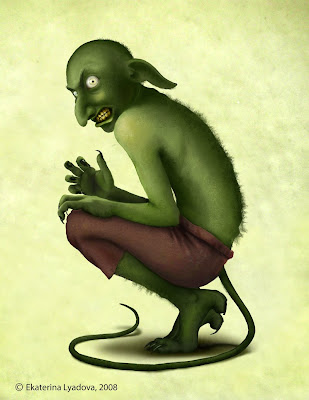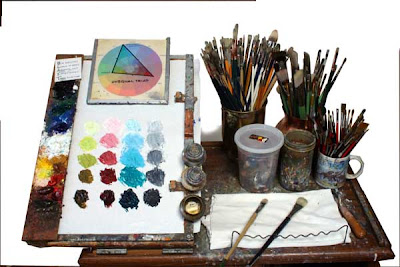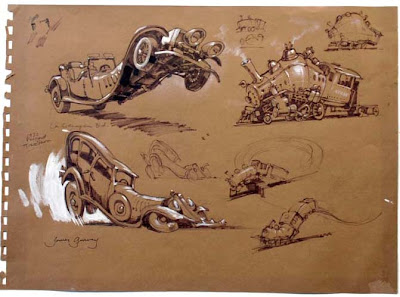
“In a time before memory, predating the Pyramids, the Sphinx and even ancient Atlantis… from the mists of an earlier age of humankind…there were unicorns, giants, and a race of tall, beautiful superior beings who came to us from another world beyond our skies.
They dwelt among us, and finding our women fair to look upon, joined with them, creating offspring. These star-children became the heroes of old, subject of legend, lore and fable, and leaders of humankind.
With the biogenetic knowledge of their forebears, they began to experiment with mixing the species. This led to the legends of the centaur, the Minotaur, the griffin and other hybrid beings, terrible servants of cruel masters."
Ms. Lyadova began by thumbnailing rough ideas, and then worked out her conception of a long-eared creature with a whiplike tail.
 According to Gary Richardson, above, a faculty member and program coordinator who prepared the new curriculum for the School of Media Studies and Information Technology, “this is part of a sequence of lessons beginning with thumbnailing and roughing out figures and composition, to story/script outline development, to character design, set design, and finally, a storyboarded sequence.”
According to Gary Richardson, above, a faculty member and program coordinator who prepared the new curriculum for the School of Media Studies and Information Technology, “this is part of a sequence of lessons beginning with thumbnailing and roughing out figures and composition, to story/script outline development, to character design, set design, and finally, a storyboarded sequence.”Mr. Richardson is dedicated to the value of traditional drawing and painting skills, and is himself a student of classic instructional texts like Bargue, Loomis, and the Famous Artists’ Course.
The students work from casts and the live model, and develop a familiarity with perspective, color theory, anatomy, and composition before they move on to mastering digital skills.
“Initially there’s some resistance to accepting traditional approach,” he said, “But once they adopt it, it does so much to advance their skill set.”
 After my slide lecture, I did a sketch demo with water-soluble colored pencils. I drew an old brass samovar in a small sketchbook, with the sketch blown up onto a giant TV screen.
After my slide lecture, I did a sketch demo with water-soluble colored pencils. I drew an old brass samovar in a small sketchbook, with the sketch blown up onto a giant TV screen. Humber is transitioning to a degree granting institution, offering 4-year degrees, 2 and 3-year diplomas, and an array of graduate certificates. It prides itself in 91% job placement for its graduates. There are 17,000 full- and part-time students in the college overall, and about 3,000 in the Media Studies program. The art program prepares students for traditional illustration, animation, or web-based opportunities.
Humber College's Visual and Digital Arts Diploma Program curriculum can be seen at:,Link.




















































